6 Standing Moves That Build Strength Without Getting on the Floor After 50
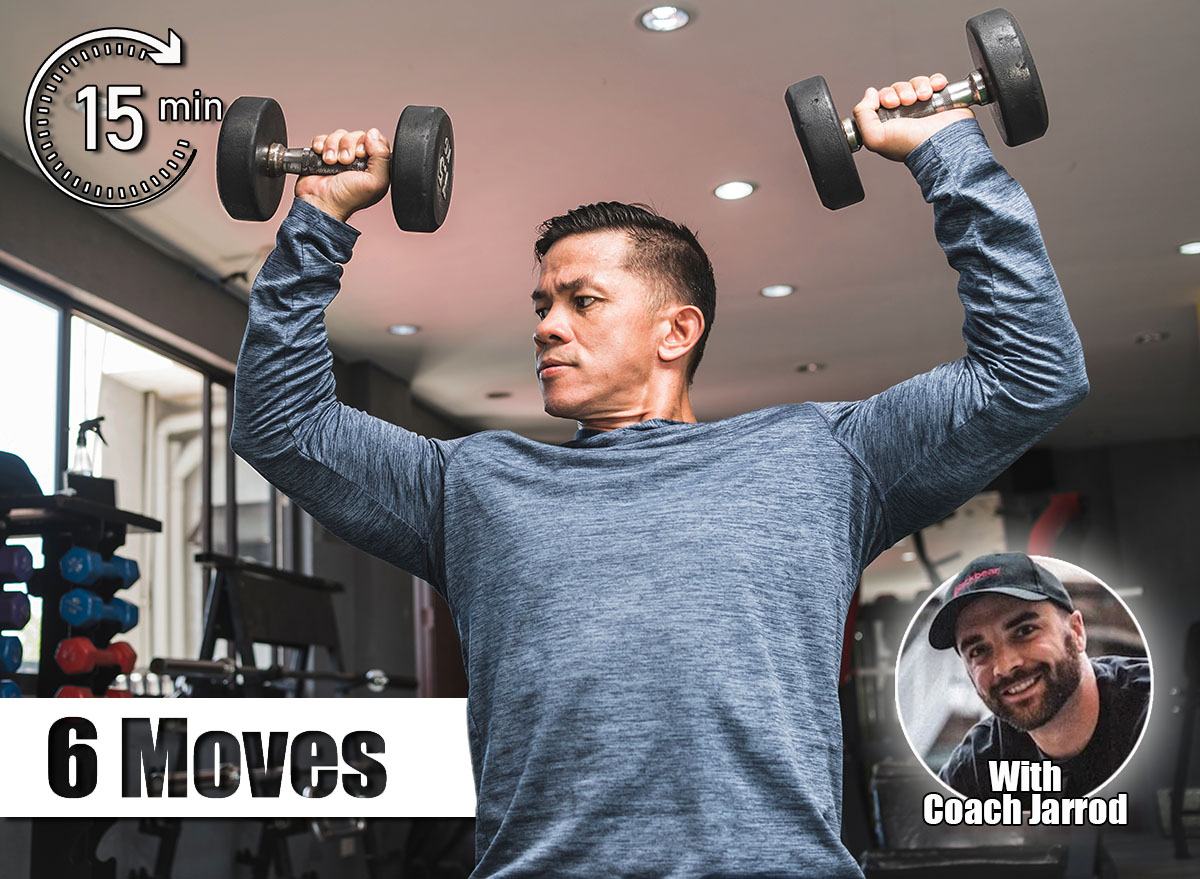
Strength training after 50 should feel practical and purposeful. The exercises you choose need to support the way you move every day, whether that’s carrying groceries, climbing stairs, or staying active with family. One of the best ways to do that is by training from a standing position.
Standing exercises recruit more muscles at once because your body has to stabilize from head to toe. Your core fires up to keep you balanced, your legs provide the foundation, and your upper body moves with greater control. This type of training mimics real-life movement patterns and helps you maintain strength that lasts.
There’s another key benefit: standing exercises improve coordination and balance while reducing unnecessary strain on your joints. That makes them especially effective for building strength safely and efficiently as you age.
The six moves below are designed to be done upright, with minimal equipment, and will give you the kind of functional strength that supports your lifestyle well beyond the gym.
6 Standing Moves That Build Strength After 50
Squat to Overhead Press
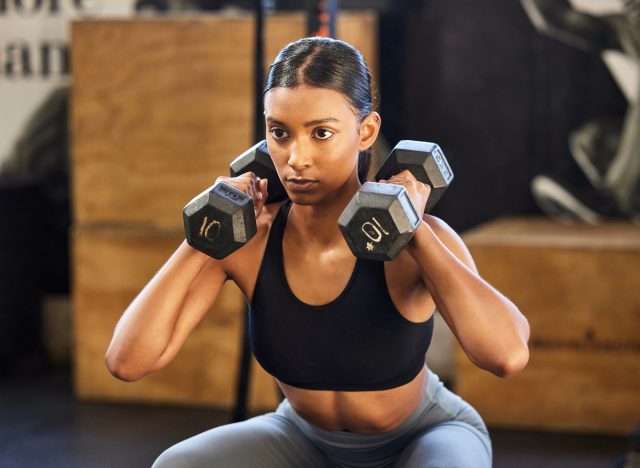
This move trains your body to generate force from the ground up, which is the foundation of everyday strength. It develops lower-body power while reinforcing core stability and shoulder strength. The overhead press portion also challenges mobility, making it a complete strength-builder that improves how you lift, carry, and move in daily life.
Muscles Trained: Quadriceps, glutes, shoulders, core
How to Do It:
- Stand with feet shoulder-width apart, holding dumbbells at shoulder height.
- Lower into a squat by pushing your hips back and bending your knees.
- Drive through your heels to return to standing.
- Press the dumbbells overhead until arms are straight.
- Lower the weights back to shoulder height and repeat.
Recommended Sets and Reps: Perform 3 sets of 8 to 12 reps. Rest 60 seconds between sets.
Best Variations: Bodyweight squat to reach, resistance band press, single-arm press.
Form Tip: Keep your chest tall and avoid letting your knees cave inward.
RELATED: 4 Simple Exercises That Build More Muscle Than Weight Training After 50
Reverse Lunge with Curl
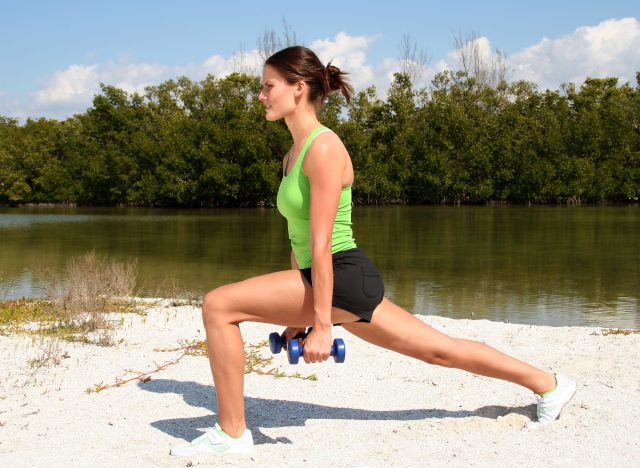
The reverse lunge improves hip stability, single-leg strength, and balance. These qualities are vital for maintaining independence after 50. Pairing it with a curl not only saves time but also builds arm strength and grip endurance, which carry over into daily activities like lifting bags and handling household tasks.
Muscles Trained: Quadriceps, hamstrings, glutes, biceps, core
How to Do It:
- Stand tall, holding dumbbells at your sides.
- Step one foot back into a reverse lunge, lowering until your front knee is bent at 90 degrees.
- As you lunge, curl the dumbbells toward your shoulders.
- Drive through the front heel to return to standing.
- Lower the weights and switch legs.
Recommended Sets and Reps: Perform 3 sets of 10 reps per leg. Rest 60 seconds between sets.
Best Variations: Bodyweight reverse lunge, alternating step-back lunges, resistance band curls.
Form Tip: Keep your torso upright and avoid leaning forward.
Standing Band Row
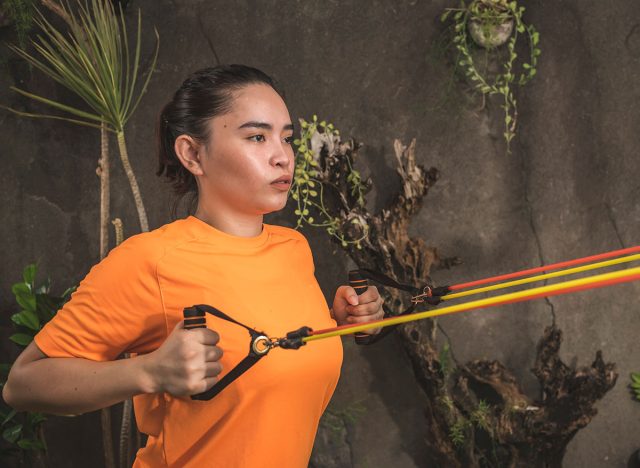
Rows strengthen the back and arms while correcting posture, a common issue that many people experience with age due to sitting and rounded shoulders. By performing them from a standing position, your core is engaged, forcing you to stabilize the spine and hips while building strong pulling strength for daily movement.
Muscles Trained: Lats, rhomboids, rear delts, biceps, core
How to Do It:
- Anchor a resistance band at chest height.
- Stand with feet hip-width apart and hold the handles.
- Pull the handles toward your ribcage, squeezing your shoulder blades together.
- Slowly release back to the start.
- Repeat with control.
Recommended Sets and Reps: Perform 3 sets of 12 to 15 reps. Rest 45 seconds between sets.
Best Variations: Dumbbell bent-over row, single-arm band row, TRX row.
Form Tip: Keep your shoulders down and avoid shrugging during the pull.
Lateral Step with Band Press
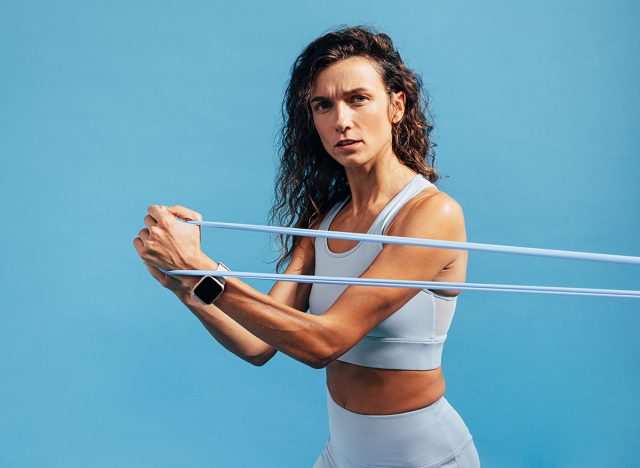
This exercise builds pushing strength while challenging your body to move sideways, a direction often neglected in training. Strengthening your lateral movement helps protect against falls, improves hip function, and adds an athletic edge to your daily activities. At the same time, the chest press builds upper-body strength for carrying and pushing tasks.
Muscles Trained: Chest, shoulders, glutes, abductors, core
How to Do It:
- Anchor a resistance band behind you at chest height.
- Hold the handles and step laterally to one side.
- As you step, press the bands straight out in front of you.
- Return to the starting position with control.
- Repeat in the opposite direction.
Recommended Sets and Reps: Perform 3 sets of 8 to 10 steps per side. Rest 45 to 60 seconds between sets.
Best Variations: Static band chest press, bodyweight lateral step, dumbbell press with step.
Form Tip: Brace your core to prevent leaning as you step and press.
Single-Leg Romanian Deadlift
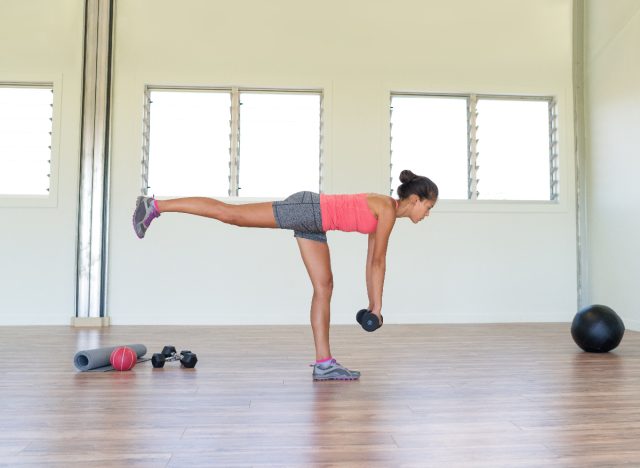
This move strengthens the posterior chain, your hamstrings, glutes, and back, while training balance in a way that directly reduces fall risk. It also reinforces hip stability, which is crucial for walking, climbing stairs, and preventing lower back pain. The balance challenge makes it both a strength and a coordination exercise.
Muscles Trained: Hamstrings, glutes, lower back, core
How to Do It:
- Stand tall, holding a dumbbell in one hand.
- Shift weight to the opposite leg and hinge forward at the hips.
- Lower the dumbbell toward the floor while extending your free leg behind you.
- Keep your back flat and core tight.
- Return to standing and repeat on the same leg.
Recommended Sets and Reps: Perform 3 sets of 8 reps per leg. Rest 60 seconds between sets.
Best Variations: Bodyweight single-leg hinge, two-arm dumbbell version, kettlebell variation.
Form Tip: Keep your hips square and avoid twisting as you hinge.
Standing Side Crunch with Weight
Core strength is about stabilizing your entire body. The standing side crunch trains the obliques while reinforcing spinal stability in an upright position. This helps protect the lower back and builds rotational strength you use when bending, twisting, or reaching in everyday life.
Muscles Trained: Obliques, abdominals, hip flexors, lower back
How to Do It:
- Stand tall, holding a dumbbell in one hand at your side.
- Place the opposite hand behind your head.
- Slowly bend sideways toward the dumbbell, engaging your obliques.
- Return to the starting position with control.
- Complete all reps on one side before switching.
Recommended Sets and Reps: Perform 3 sets of 12 to 15 reps per side. Rest 45 seconds between sets.
Best Variations: Bodyweight side bends, band-resisted side crunch, overhead side bends.
Form Tip: Keep the movement strictly side-to-side without leaning forward or backward.
Best Habits to Maximize Your Standing Workouts After 50
Building strength after 50 goes beyond the exercises you perform. Pairing smart lifestyle habits with these standing moves will accelerate your progress and keep you consistent.
- Warm up before training: Loosen stiff joints with light marching in place, arm circles, or band pull-aparts. This primes your muscles and reduces injury risk.
- Mix strength with mobility: Add stretches and mobility drills to keep your hips, shoulders, and spine moving well. Flexibility supports strength.
- Prioritize protein: Aim for a protein-rich meal or snack after your workout to fuel muscle repair and recovery.
- Stay consistent: Even 20 minutes of standing strength training three days per week can lead to noticeable improvements over time.
- Balance training with walking: Daily walking improves circulation, heart health, and reinforces the endurance needed to make strength gains stick.
These habits, combined with the six standing moves above, will help you stay strong, balanced, and confident in everything you do.
Looking for more easy ways to lose fat? Here’s How Long Your Walking Workout Should Be To Shrink Belly Fat.